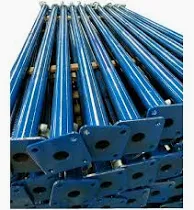Aug . 12, 2024 07:10 Back to list
Wooden Formwork Solutions for Concrete Construction Industry Exporters and Manufacturers Worldwide
Wooden Formwork for Concrete A Guide for Exporters
Wooden formwork has long been a cornerstone of the construction industry, providing essential support and shape for concrete structures. Its versatility, affordability, and ease of use make it a favored choice among builders worldwide. In recent years, the global demand for wooden formwork for concrete has surged, opening up new opportunities for exporters in this sector. This article delves into the key aspects of wooden formwork, its advantages, and considerations for exporters looking to break into this market.
The Basics of Wooden Formwork
Formwork is a temporary or permanent mold into which concrete is poured to give it shape as it hardens. Wooden formwork specifically involves using timber—often plywood or engineered wood—as the primary material. It is praised for its adaptability in various construction projects, from residential buildings to large infrastructural works.
Advantages of Wooden Formwork
1. Cost-Effectiveness Wooden formwork typically offers a lower initial investment compared to other materials like metal or plastic. This cost advantage is particularly appealing for small to medium-sized construction projects.
2. Ease of Handling Wood is lightweight and can be easily cut, shaped, and assembled on-site. This ease of use can significantly reduce labor costs and time during the installation process.
3. Versatility Wooden formwork can be customized to accommodate different shapes and sizes required for diverse architectural designs. This flexibility enables contractors to meet specific project requirements without the need for extensive modifications.
4. Sustainability When sourced from responsibly managed forests, wooden formwork contributes to sustainable construction practices. Unlike many synthetic materials, wood is biodegradable, posing less environmental impact when disposed of correctly.
wooden formwork for concrete exporters

Export Market for Wooden Formwork
With increased urbanization and infrastructure development globally, the demand for construction materials, including wooden formwork, continues to rise. Exporters have a crucial role in meeting this demand, especially in regions with emerging construction markets.
1. Target Markets Potential export markets include developing nations in Africa, Asia, and Latin America, where rapid urban development calls for affordable building solutions. Countries with significant infrastructure projects are also promising markets.
2. Regulations and Standards Different regions have specific compliance requirements for construction materials. Exporters need to familiarize themselves with international standards and local regulations regarding building materials to ensure their products meet necessary safety and quality benchmarks.
3. Logistics and Distribution Efficient logistics play a vital role in the success of wooden formwork exports. Exporters must establish reliable supply chains, considering factors like shipping costs, lead times, and storage conditions to maintain the quality of wooden products.
4. Marketing Strategies In a competitive export market, strong branding and marketing strategies are essential. Highlighting the benefits of wooden formwork, such as sustainability, cost-effectiveness, and versatility, can attract potential buyers. Participation in international trade fairs and online platforms can also enhance visibility to prospective clients.
Conclusion
Wooden formwork for concrete represents a significant opportunity for exporters looking to tap into the growing construction industry. By understanding the advantages of wooden formwork, navigating the complexities of international markets, and implementing effective business strategies, exporters can successfully position themselves in this lucrative market. As global construction demands evolve, the adaptability and sustainability of wooden formwork will continue to make it an appealing choice for builders and developers alike.
-
Heavy Duty Props EN1065 Certified - Adjustable Steel Shoring for Formwork
NewsJul.21,2025
-
Heavy Duty Tripod & Fork Head: Stable Camera Mount for Pro Shots
NewsJul.21,2025
-
High-Quality U Head Jack Scaffolding – Reliable Scaffolding Jack Head Manufacturer & Factory
NewsJul.08,2025
-
High-Quality I Beam H20 Leading Timber Beam H20 Material Factory, Exporters & Manufacturers
NewsJul.08,2025
-
High-Quality Powder Coating Steel Formwork - Durable & Corrosion Resistant Solutions
NewsJul.07,2025
-
Inclined Column Formwork Supplier – Durable & Precise Solutions for Unique Structures
NewsJul.07,2025